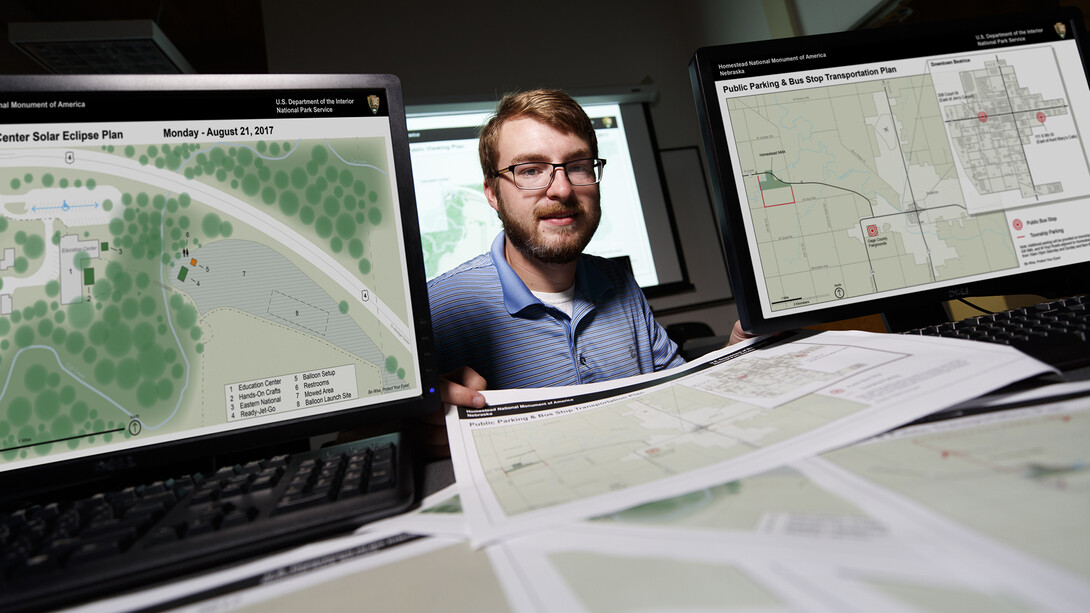
A third-year landscape architecture student at the University of Nebraska-Lincoln is helping a National Park Service-managed site near Beatrice, Nebraska, brace for thousands of visitors expected for the total solar eclipse Aug. 21.
As a result of Austin Arens’ work, the Homestead National Monument will come away with state-of-the-art maps of its grounds and transportation routes to and from Beatrice. In turn, the student is flexing the high-tech skills he’s gained through his academic program while building professional relationships and work experience for his future career.
“All the stuff I’ve learned in the last two years, I’m getting to go out and use it to benefit the Park Service with this huge event,” he said.
Professor Kim Wilson, Arens’ adviser and director of the landscape architecture program, said Arens’ work at Homestead is a prime example of the program’s deepening relationship with the National Park Service. Past students have worked at the Scotts Bluff National Monument in western Nebraska and the National Park Service’s Midwest Region headquarters on Omaha’s riverfront.
The partnership with the Park Service was formalized in summer 2017 via a formal agreement between the landscape architecture program and Park Service’s Midwest Regional Office, based in Omaha. The agreement assures that students will continue to have opportunities to work on Park Service projects in the region.
“Students love working on these kinds of projects testing their skills and knowledge relating to landscape architecture,” Wilson said. “And their contributions provide the National Park Service the ability to get some projects addressed.”
Though students can’t substitute for licensed professionals on work projects, she said, they often provide valuable input as park officials plan for improvements.
The Homestead monument is one about a dozen sites in the eclipse path selected by NASA as an official viewing site. The totality of the eclipse – when the moon is fully in front of the sun – is expected to last more than 2½ minutes at Homestead. Beatrice is among Nebraska cities with near-maximum periods of totality. Officials with Beatrice and with Homestead expect tens of thousands of people to watch the eclipse and have planned a weekend of activities that include star-gazing, fiddle bands, Native American lore, NASA experts and Bill Nye, the science guy.
“Austin’s maps are going to be essential to the work of our team of volunteers, National Park Service employees and community partners in orchestrating this event,” said Mark Engler, superintendent at Homestead National Monument. “We’ve never had the services that Austin and Kim are bringing to help us with mapping. It’s really a critical component to our event.”
The maps have been an aid as park employees have planned for NASA-specified equipment and fixtures and how to direct the flow of visitors to the site.
Arens, who receives a stipend for his work through the University’s Undergraduate Creative Activity and Research Experience (UCARE) program, began working at Homestead or the Midwest regional office one or two days a week in June. Using AutoCAD and GIS technology, he has drawn maps of the site that shows bus pick-up points and routes between the City of Beatrice and the monument. He has made parking zone signs, banners and safety messages reminding viewers to wear safety glasses.
He also has attended weekly staff meetings in Beatrice to offer his input and to learn more about the teamwork that goes into staging a large event.
Wilson calls Arens’ diagrams “context” maps because they depict the monument grounds in geographical context with the region. Aerial images and Geographic Information Systems data add more precise detail to the monument’s existing maps. Arens also used software tools to simplify, highlight and emphasize information so that the maps are easily comprehended by visitors to the monument. The maps are designed in typographical style consistent with visitor guide maps typically distributed at all national park sites. In addition, Arens’ computer files can be used by monument staff to create new maps for other activities in the future.
Arens previously gained map-making experience while on a sustainable design study abroad trip led by Wilson to Galapagos and Quito, Ecuador.
“Now he’s applying these skills for the benefit of the National Park Service,” Wilson said. “It’s a cool thing – it’s service learning and meeting a need for a government agency.” Arens is organizing a group of about 20 student volunteers from the university’s chapter of the American Society of Landscape Architects to help with crowd management at Homestead on Aug. 21.
His Homestead work is to continue after the eclipse, when he will help Homestead staff update exhibits on native prairie and implement a preservation and upkeep plan for an Osage Orange hedge row originally planted by Daniel Freeman, the first homesteader.
“He’s not just talking the talk – he’s walking the walk,” Wilson said.
“I’m getting to experience what life is like beyond academia, in the real world,” Arens said. “I’m learning about all the teamwork that’s needed to put together a huge event.”







